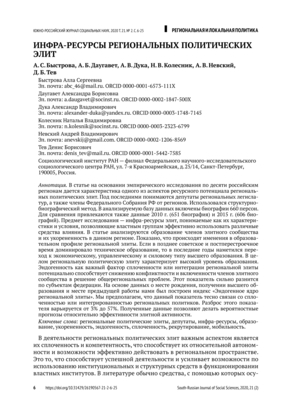Abstract
The article analyzes one of the aspects of the regional political elites’ resourse potential on the basis of an empirical study of ten Russian regions. The latter are deputies of regional legislatures, as well as regional members of the Federal Assembly of the Russian Federation. The structural and biographical method was used to examine the database of 650 persons’ biographies. The earlier data (651 entries from 2010 and 606 entries from 2015) are also used to compare the results. The subject of the research is the elites’ infra-resources understood as characteristics and conditions that allow power groups to effectively use various means of influence. The research dwells upon the educational background of the elite community members and their embeddedness in the region. A change in the educational background has been registered. While in the late Soviet and post-perestroyka times preference was given to technical education, in recent years economic, managerial and military types of education are dominant. On the whole, the level of education among regional political elite is high. Endogenousness, as an important factor in the cohesion or integration of regional elites, has the potential to reduce conflict and the involvement of members of the elite community in the solution of region-wide problems. This figure varies considerably among the federated entities. On the basis of data on place of birth, higher education and place of previous work we built the index «Endogenous core of regional elite». We assume that this indicator is closely linked to the cohesion or integration of regional policymakers. The sparseness varies from 3% to 57%. The data obtained allow making probabilistic predictions about the efficiency of elite activity.
Keywords
References
Андрущак, Г.В., Гохберг, Л.М., Ковалева, Н.В., Кузьминов, Я.И. (ред.) (2014). Образование в цифрах: 2014: краткий статистический сборник. М.: НИУ ВШЭ.
Барсукова, С., Звягинцев, В. (2006). Механизм «политического инвестирования», или Как и зачем бизнес участвует в выборах и оплачивает партийную жизнь. Политические исследования, 2, 110–121. DOI: 10.17976/jpps/2006.02.09
Боровская, М.А., Гохберг, Л.М., Кузьминов, Я.И. (ред.) (2019). Образование в цифрах: 2019: краткий статистический сборник. М.: НИУ ВШЭ.
Быстрова, А., Дука, А., Колесник, Н., Невский, А., Тев, Д. (2008). Российские региональные элиты: инновационный потенциал в контексте глобализации. В И.И. Елисеева (ред.) Глобализация в российском обществе: сб. науч. трудов (99–243). СПб.: Нестор-История.
Витковская, Т.Б. (2019). Политическое пространство промышленных городов Урала: крупные предприятия в политике и управлении. Власть и элиты, 6(1), 197–215. DOI: https://doi.org/10.31119/pe.2019.6.1.9
Гаман-Голутвина, О.В. (1999, Июнь 2). Террариум единомышленников. Независимая газета.
Гаман-Голутвина, О.В. (2016). Политические элиты как объект исследований в отечественной политической науке. Политическая наука, 2, 38–73.
Гидденс, Э. (2003). Устроение общества: Очерк теории структурации. М.: Академический Проект.
Грановеттер, М. (2004). Экономическое действие и социальная структура: проблема укорененности. В В.В. Радаев (ред.) Западная экономическая социология: Хрестоматия современной классики (с. 131–158). М.: РОССПЭН.
Громов, А.Д., Платонова, Д.П., Семенов, Д.С., Пырова, Т.Л. (2016). Доступность высшего образования в регионах России. М.: НИУ ВШЭ.
Дай, Т.Р., Зиглер, Л.Х. (1984). Демократия для элиты: Введение в американскую политику. М.: Юрид. лит.
Долгополов, Д. (2018, Октябрь 1). Эксперты проекта «Госзатраты»: больше половины средств госзаказа в регионах России получают местные поставщики. 7x7. Новости, мнения, блоги. Режим доступа https://7x7‑journal.ru/articles/2018/10/01/eksperty-proekta-goszatraty-bolshe-poloviny-sredstv-goszakaza-v-regionah-rossii-poluchayut-mestnye-postavshiki
Исаев, Д.П., Трапш, Н.А. (2016). Управленческая элита советских и российских регионов в ракурсе трансформирующейся профессиональной идентичности. Гуманитарные и юридические исследования, 4, 49–57.
Колесник, Н.В. (2019). Образовательные траектории российской элиты: региональная проекция. Мир России, 4, 30–48.
Крыштановская, О. (2019) Элита в сетях: новые формы обратной связи в цифровую эпоху. Цифровая социология, 2(2), 4–11. DOI: 10.26425/2658-347X‑2019-2-4-11
Миллс, Р. (1959). Властвующая элита. М.: Изд-во иностр. лит-ры.
Патнэм, Р. (1996). Чтобы демократия сработала: Гражданские традиции в современной Италии. М.: Ad Marginem.
Самнер, У.Г. (1998). Народные обычаи. Исследование социологического значения обычаев, манер, привычек, нравов и этики. Рубеж: альманах социологических исследований, 12, 10–32.
Семенова, В.В., Черныш, М.Ф., Сушко П.Е. (ред.). (2019). Социальная мобильность в усложняющемся обществе: объективные и субъективные аспекты. М.: ФНИСЦ РАН.
Старостина, Ю. (2020, Февраль 26). Счетная палата назвала Чечню лидером регионального протекционизма. РБК. Режим доступа https://www.rbc.ru/economics/26/02/2020/5e55460d9a79472e99363438
Тев, Д.Б. (2016). Федеральная административная элита России: образовательные характеристики. Мир России, 3, 76–96.
Федеральная служба государственной статистики (2010). Всероссийская перепись населения 2010 года. Режим доступа https://www.gks.ru/free_doc/new_site/perepis2010/croc/perepis_itogi1612.htm
Финансовый университет при Правительстве РФ (2014). Рейтинги вузов по образованию представителей элиты государственного управления России‑2014. Режим доступа http://www.old.fa.ru/news/Documents/GovElite.pdf
Шестопал, Е.Б., Селезнева, А.В. (ред.) (2012). Человеческий капитал российских политических элит. Политико-психологический анализ. М.: РАПН; РОССПЭН.
Aberbach, J.D., Putnam, R.D., Rockman, B.A. (1981). Bureaucrats and Politicians in Western Democracies. Cambridge, Mass.; London: Harvard University Press.
Best, H. (2010) Associated Rivals: Antagonism and Cooperation in the German Political Elite. In H. Best & J. Higley (Eds.) Democratic Elitism: New Theoretical and Comparative Perspectives (pp. 97–116). Leiden, The Netherlands; Boston: Brill.
Burnham, J. (1943). The Machiavellians: Defenders of Freedom. New York: The John Day Company.
Dorling, D. (2010). The Return to Elitism in Education. Soundings, 44, 35–46.
Engelstad, F. (2018). Models of Elite Integration. In H. Best & J. Higley (Eds.) The Palgrave Handbook of Political Elites (pp. 439–457). London: Palgrave Macmillan.
Hartmann, M. (2010). Elites and Power Structure. In S. Immerfall, G. Therborn (Eds.) Handbook of European Societies. Social Transformations in the 21st Century (p. 291–323). Berlin; New York: Springer.
Hicks, A., Misra, J. (1993). Political Resources and the Growth of Welfare in Affluent Capitalist Democracies, 1960–1982. American Journal of Sociology, 99(3), 668–710.
Hoffmann-Lange, U. (2018). Theory-Based Typologies of Political Elites. In H. Best & J. Higley (Eds.) The Palgrave Handbook of Political Elites (pp. 53–68). London: Palgrave Macmillan.
Huskey, E. (2010). Elite Recruitment and State-Society Relations in Technocratic Authoritarian Regimes: The Russian Case. Communist and Post-Communist Studies, 43(4), 363–372.
London, B., Anderson, K.L. (1985). Population Density, Elites, and the Destribution of Infrastructural Resources in Thailand. The Sociological Quarterly, 26(2), 235–249.
Meisel, J.H. (1962). The Myth of the Ruling Class: Gaetano Mosca and the “Elite”. With the first English Translation of the Final Version of “The Ruling Class”. Ann Arbor: Univ. of Michigan Press.
Putnam, R.D. (1976). The Comparative Study of Political Elites. Englewood Cliffs, NJ: Prentice-Hall.
Rogers, M.F. (1974). Instrumental and Infra-Resources: The Bases of Power. American Journal of Sociology, 79(6), 1418–1433.


